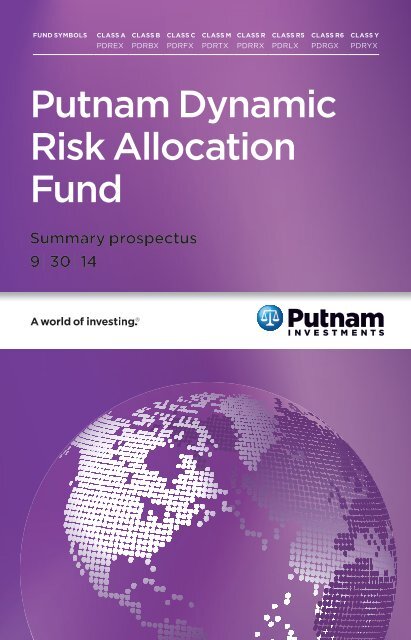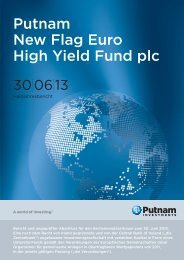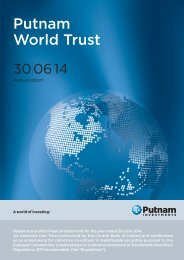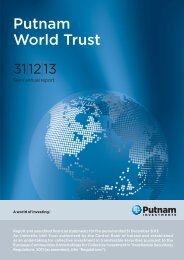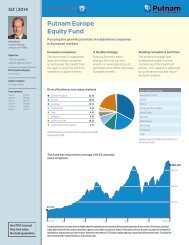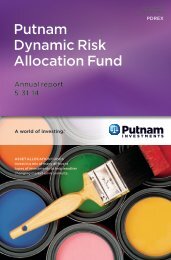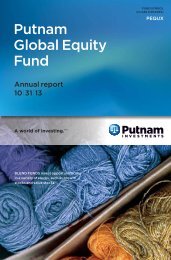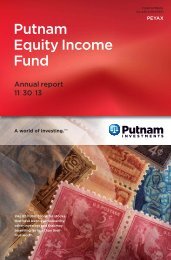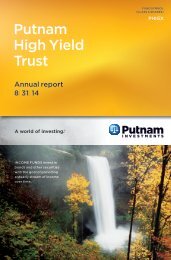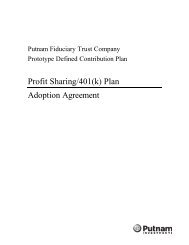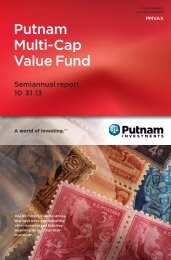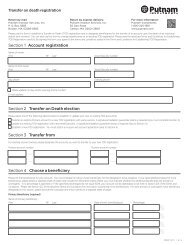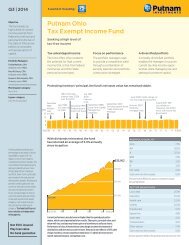Putnam Dynamic Risk Allocation Fund - Putnam Investments
Putnam Dynamic Risk Allocation Fund - Putnam Investments
Putnam Dynamic Risk Allocation Fund - Putnam Investments
You also want an ePaper? Increase the reach of your titles
YUMPU automatically turns print PDFs into web optimized ePapers that Google loves.
FUND SYMBOLS CLASS A CLASS B CLASS C CLASS M CLASS R CLASS R5 CLASS R6 CLASS Y<br />
PDREX PDRBX PDRFX PDRTX PDRRX PDRLX PDRGX PDRYX<br />
<strong>Putnam</strong> <strong>Dynamic</strong><br />
<strong>Risk</strong> <strong>Allocation</strong><br />
<strong>Fund</strong><br />
Summary prospectus<br />
9 | 30 | 14
<strong>Putnam</strong> <strong>Dynamic</strong> <strong>Risk</strong><br />
<strong>Allocation</strong> <strong>Fund</strong><br />
Before you invest, you may wish to review the fund’s prospectus, which<br />
contains more information about the fund and its risks. You may obtain the<br />
prospectus and other information about the fund, including the statement<br />
of additional information (SAI) and most recent reports to shareholders, at<br />
no cost by visiting putnam.com/funddocuments, calling 1-800-225-1581, or<br />
e-mailing <strong>Putnam</strong> at funddocuments@putnam.com.<br />
The fund’s prospectus and SAI, both dated 9/30/14, are incorporated by<br />
reference into this summary prospectus.<br />
Goal<br />
<strong>Putnam</strong> <strong>Dynamic</strong> <strong>Risk</strong> <strong>Allocation</strong> <strong>Fund</strong> seeks total return. Total return is<br />
composed of capital appreciation and income.<br />
Fees and expenses<br />
The following table describes the fees and expenses you may pay if you buy<br />
and hold shares of the fund. You may qualify for sales charge discounts if you<br />
and your family invest, or agree to invest in the future, at least $50,000 in<br />
<strong>Putnam</strong> funds. More information about these and other discounts is available<br />
from your financial advisor and in How do I buy fund shares beginning on<br />
page 21 of the fund’s prospectus and in How to buy shares beginning on<br />
page II-1 of the fund’s statement of additional information (SAI).<br />
Shareholder fees (fees paid directly from your investment)<br />
Share class<br />
Maximum sales charge (load)<br />
imposed on purchases (as a<br />
percentage of offering price)<br />
Maximum deferred sales charge<br />
(load) (as a percentage of original<br />
purchase price or redemption<br />
proceeds, whichever is lower)<br />
Class A 5.75% 1.00%*<br />
Class B NONE 5.00%**<br />
Class C NONE 1.00%***<br />
Class M 3.50% 0.65%*<br />
Class R NONE NONE<br />
Class R5 NONE NONE<br />
Class R6 NONE NONE<br />
Class Y NONE NONE<br />
2
Annual fund operating expenses<br />
(expenses you pay each year as a percentage of the value of your investment)<br />
Share<br />
class<br />
Management<br />
fees<br />
Distribution<br />
and service<br />
(12b-1)<br />
fees<br />
Other<br />
expenses<br />
Acquired<br />
fund fees<br />
and<br />
expenses<br />
Total<br />
annual fund<br />
operating<br />
expenses<br />
Expense<br />
reimbursement<br />
#<br />
Total<br />
annual fund<br />
operating<br />
expenses<br />
after<br />
expense<br />
reimbursement<br />
Class A 0.90% 0.25% 0.35% 0.02% 1.52% (0.10)% 1.42%<br />
Class B 0.90% 1.00% 0.35% 0.02% 2.27% (0.10)% 2.17%<br />
Class C 0.90% 1.00% 0.35% 0.02% 2.27% (0.10)% 2.17%<br />
Class M 0.90% 0.75% 0.35% 0.02% 2.02% (0.10)% 1.92%<br />
Class R 0.90% 0.50% 0.35% 0.02% 1.77% (0.10)% 1.67%<br />
Class R5 0.90% N/A 0.31% 0.02% 1.23% (0.06)% 1.17%<br />
Class R6 0.90% N/A 0.21% 0.02% 1.13% 0.00% 1.13%<br />
Class Y 0.90% N/A 0.35% 0.02% 1.27% (0.10)% 1.17%<br />
* Applies only to certain redemptions of shares bought with no initial sales charge.<br />
** This charge is phased out over six years.<br />
*** This charge is eliminated after one year.<br />
# Reflects <strong>Putnam</strong> Investment Management, LLC’s contractual obligation to limit certain fund<br />
expenses through at least September 30, 2015. This obligation may be modified or discontinued<br />
only with approval of the Board of Trustees.<br />
Example<br />
The following hypothetical example is intended to help you compare the cost<br />
of investing in the fund with the cost of investing in other funds. It assumes<br />
that you invest $10,000 in the fund for the time periods indicated and then,<br />
except as indicated, redeem all your shares at the end of those periods.<br />
It assumes a 5% return on your investment each year and that the fund’s<br />
operating expenses remain the same. Only the first year of each period in the<br />
example takes into account the expense reimbursement described above.<br />
Your actual costs may be higher or lower.<br />
3
Share class 1 year 3 years 5 years 10 years<br />
Class A $711 $1,018 $1,347 $2,275<br />
Class B $720 $1,000 $1,406 $2,409<br />
Class B (no redemption) $220 $700 $1,206 $2,409<br />
Class C $320 $700 $1,206 $2,598<br />
Class C (no redemption) $220 $700 $1,206 $2,598<br />
Class M $538 $952 $1,391 $2,608<br />
Class R $170 $547 $950 $2,076<br />
Class R5 $119 $384 $670 $1,483<br />
Class R6 $115 $359 $622 $1,375<br />
Class Y $119 $393 $687 $1,525<br />
Portfolio turnover<br />
The fund pays transaction-related costs, such as commissions, when it buys<br />
and sells securities (or “turns over” its portfolio). A higher turnover rate<br />
may indicate higher transaction costs and may result in higher taxes when<br />
the fund’s shares are held in a taxable account. These costs, which are not<br />
reflected in annual fund operating expenses or the above example, affect fund<br />
performance. The fund’s turnover rate in the most recent fiscal year was 117%.<br />
<strong>Investments</strong>, risks, and performance<br />
<strong>Investments</strong><br />
The fund invests in a diversified set of asset classes. By investing in a broader<br />
set of asset classes than a traditional balanced fund, and by using leverage<br />
to increase the fund’s exposures to asset classes we believe that the fund<br />
may achieve a higher total return than a traditional balanced fund with<br />
approximately the same amount of risk as a traditional balanced fund. <strong>Risk</strong> is<br />
measured by the volatility of the fund’s investment portfolio.<br />
The fund may invest without limit in U.S., international, and emerging markets<br />
equity securities (growth or value stocks or both) of companies of any size<br />
and fixed-income securities (including in below-investment-grade securities,<br />
which are sometimes referred to as “junk bonds”); mortgage- and assetbacked<br />
securities; inflation-protected securities; commodities; and real estate<br />
investment trusts (REITs). These asset classes offer different return potential<br />
and exposure to different investment risks.<br />
We allocate the fund’s assets among asset classes in a manner intended to<br />
diversify the fund’s exposure to these different types of risk. We typically use<br />
leverage to adjust or to increase the fund’s exposure to certain asset classes<br />
in order to diversify, or balance, risk exposure. We expect that, on average,<br />
net notional investment exposure of approximately 150% of the net assets of<br />
the fund will result from the fund’s allocation strategy under normal market<br />
4
conditions, although the amounts of leverage may be significantly higher or<br />
lower at any given time. We believe that better risk diversification creates the<br />
potential for the fund to perform well in a variety of market environments.<br />
Because the potential risks and returns of asset classes, the costs of leverage,<br />
and the benefits of diversification vary over time and with market conditions,<br />
we make dynamic adjustments to the fund’s asset allocations as the market<br />
environment changes. We use qualitative analysis, which includes evaluation<br />
of the business cycle environment and its impact on different asset classes,<br />
and quantitative techniques, which incorporate individual valuation and<br />
relative valuation measures, to establish asset class allocations that we believe<br />
will enable the fund to perform well in a variety of environments. We also<br />
use active trading strategies, such as active security selection, tactical asset<br />
allocation, currency transactions and options transactions. Certain of these<br />
strategies may introduce additional investment leverage.<br />
When making particular investments within an asset class, we may consider,<br />
among other factors, a company’s valuation, financial strength, growth<br />
potential, competitive position in its industry, projected future earnings, cash<br />
flows and dividends when deciding whether to buy or sell equity investments,<br />
and, among other factors, credit, interest rate and prepayment risks when<br />
deciding whether to buy or sell fixed income investments. We may also take<br />
into account general market conditions when making investment decisions.<br />
We typically use derivatives, such as futures, options, certain foreign currency<br />
transactions, warrants and swap contracts, to a significant extent for<br />
hedging purposes, to obtain leverage, and to adjust the return and volatility<br />
characteristics of the fund’s investments. We may also engage in short sales<br />
of securities.<br />
<strong>Risk</strong>s<br />
It is important to understand that you can lose money by investing in the fund.<br />
Our allocation of assets among asset classes may hurt performance, and<br />
our efforts to diversify risk through the use of leverage and allocation<br />
decisions may not be successful. The value of stocks and bonds in the fund’s<br />
portfolio may fall or fail to rise over extended periods of time for a variety<br />
of reasons, including general financial market conditions, changing market<br />
perceptions of the risk of default, changes in government intervention in the<br />
financial markets, and factors related to a specific issuer or industry. These<br />
factors may also lead to periods of high volatility and reduced liquidity in<br />
the bond markets. Growth stocks may be more susceptible to earnings<br />
disappointments, and value stocks may fail to rebound. These risks are<br />
generally greater for small and midsize companies. Bond markets may, in<br />
5
esponse to government intervention, economic or market developments, or<br />
other factors, experience periods of high volatility and reduced liquidity.<br />
Bond investments include interest rate risk, which means the value of the<br />
fund’s bond investments is likely to fall if interest rates rise. Bond investments<br />
also are subject to credit risk, which is the risk that the issuer of the bond<br />
may default on payment of interest or principal. Interest rate risk is generally<br />
greater for longer-term bonds, and credit risk is generally greater for<br />
below-investment-grade bonds, which may be considered speculative.<br />
Mortgage-backed investments carry the risk that they may increase in value<br />
less when interest rates decline and decline in value more when interest rates<br />
rise. We may have to invest the proceeds from prepaid investments, including<br />
mortgage- and asset-backed investments, in other investments with less<br />
attractive terms and yields.<br />
The value of international investments traded in foreign currencies may be<br />
adversely impacted by fluctuations in exchange rates. International investments,<br />
particularly investments in emerging markets, may carry risks associated with<br />
potentially less stable economies or governments (such as the risk of seizure by<br />
a foreign government, the imposition of currency or other restrictions, or high<br />
levels of inflation or deflation), and may be or become illiquid. Our active trading<br />
strategies may lose money or not earn a return sufficient to cover trading and<br />
other costs. REITs are subject to the risk of economic downturns that have an<br />
adverse impact on real estate markets. Commodity-linked notes are subject to<br />
the same risks as commodities, such as weather, disease, political, tax and other<br />
regulatory developments and other factors affecting the value of commodities.<br />
Our use of leverage obtained through derivatives increases these risks by<br />
increasing investment exposure. Derivatives also involve the risk, in the case of<br />
many over-the-counter instruments, of the potential inability to terminate or sell<br />
derivatives positions and the potential failure of the other party to the instrument<br />
to meet its obligations. Our use of short selling may result in losses if the securities<br />
appreciate in value.<br />
The fund may not achieve its goal, and it is not intended to be a complete<br />
investment program. An investment in the fund is not insured or<br />
guaranteed by the Federal Deposit Insurance Corporation or any other<br />
government agency.<br />
Performance<br />
The performance information below gives some indication of the risks<br />
associated with an investment in the fund by showing the fund’s performance<br />
year to year and over time. The bar chart does not reflect the impact of<br />
sales charges. If it did, performance would be lower. Please remember that<br />
6
past performance is not necessarily an indication of future results. Monthly<br />
performance figures for the fund are available at putnam.com.<br />
Annual total returns for class A shares before sales charges<br />
11.55%<br />
4.00%<br />
2012 2013<br />
Year-to-date<br />
performance<br />
through 6/30/14<br />
Best calendar<br />
quarter<br />
Q1 2012<br />
Worst calendar<br />
quarter<br />
Q2 2013<br />
6.36%<br />
6.15%<br />
–5.50%<br />
Average annual total returns after sales charges<br />
(for periods ending 12/31/13)<br />
Share class<br />
1 year<br />
Since inception<br />
(9/19/11)<br />
Class A before taxes –1.98% 4.23%<br />
Class A after taxes on distributions –2.12% 3.43%<br />
Class A after taxes on distributions<br />
and sale of fund shares –1.01% 3.04%<br />
Class B before taxes –1.84% 4.92%<br />
Class C before taxes 2.13% 6.16%<br />
Class M before taxes –0.15% 4.81%<br />
Class R before taxes 3.74% 6.70%<br />
Class R5 before taxes* 4.33% 7.31%<br />
Class R6 before taxes* 4.35% 7.34%<br />
Class Y before taxes 4.28% 7.27%<br />
<strong>Putnam</strong> <strong>Dynamic</strong> <strong>Risk</strong> <strong>Allocation</strong><br />
Blended Index (no deduction for fees,<br />
expenses or taxes, other than withholding taxes<br />
on reinvested dividends in the case of the MSCI<br />
World Index (ND)) 11.45% 9.84%<br />
* Performance for class R5 and class R6 shares prior to their inception (7/2/12) is derived from<br />
the historical performance of class Y shares, and has not been adjusted for the lower investor<br />
servicing fees applicable to class R5 and class R6 shares; had it, returns would have been higher.<br />
The <strong>Putnam</strong> <strong>Dynamic</strong> <strong>Risk</strong> <strong>Allocation</strong> Blended Index is an unmanaged index administered by<br />
<strong>Putnam</strong> Management, 50% of which is the MSCI World Index (ND), 40% of which is the Barclays<br />
Global Aggregate Bond Index, and 10% of which is the S&P GSCI.<br />
After-tax returns reflect the historical highest individual federal marginal income tax rates<br />
and do not reflect state and local taxes. Actual after-tax returns depend on an investor’s tax<br />
situation and may differ from those shown. After-tax returns are shown for class A shares only<br />
and will vary for other classes. These after-tax returns do not apply if you hold your fund shares<br />
through a 401(k) plan, an IRA, or another tax-advantaged arrangement.<br />
7
Your fund’s management<br />
Investment advisor<br />
<strong>Putnam</strong> Investment Management, LLC<br />
Portfolio managers<br />
James Fetch, Co-Head of Global Asset <strong>Allocation</strong>, portfolio manager of the<br />
fund since 2011<br />
Robert Kea, Co-Head of Global Asset <strong>Allocation</strong>, portfolio manager of the<br />
fund since 2011<br />
Joshua Kutin, Portfolio Manager, portfolio manager of the fund since 2011<br />
Robert Schoen, Co-Head of Global Asset <strong>Allocation</strong>, portfolio manager of the<br />
fund since 2011<br />
Jason Vaillancourt, Co-Head of Global Asset <strong>Allocation</strong>, portfolio manager of<br />
the fund since 2011<br />
Purchase and sale of fund shares<br />
You can open an account, purchase and/or sell fund shares, or exchange them<br />
for shares of another <strong>Putnam</strong> fund by contacting your financial advisor or by<br />
calling <strong>Putnam</strong> Investor Services at 1-800-225-1581.<br />
When opening an account, you must complete and mail a <strong>Putnam</strong> account<br />
application, along with a check made payable to the fund, to: <strong>Putnam</strong> Investor<br />
Services, P.O. Box 8383, Boston, MA 02266-8383. The minimum initial<br />
investment of $500 is currently waived, although <strong>Putnam</strong> reserves the right<br />
to reject initial investments under $500 at its discretion. There is no minimum<br />
for subsequent investments.<br />
You can sell your shares back to the fund or exchange them for shares of<br />
another <strong>Putnam</strong> fund any day the New York Stock Exchange (NYSE) is open.<br />
Shares may be sold or exchanged by mail, by phone, or online at putnam.com.<br />
Some restrictions may apply.<br />
8
Tax information<br />
The fund’s distributions will be taxed as ordinary income or capital gains<br />
unless you hold the shares through a tax-advantaged arrangement, in<br />
which case you will generally be taxed only upon withdrawal of monies from<br />
the arrangement.<br />
Financial intermediary compensation<br />
If you purchase the fund through a broker/dealer or other financial<br />
intermediary (such as a bank or financial advisor), the fund and its related<br />
companies may pay that intermediary for the sale of fund shares and related<br />
services. Please bear in mind that these payments may create a conflict of<br />
interest by influencing the broker/dealer or other intermediary to recommend<br />
the fund over another investment. Ask your advisor or visit your advisor’s<br />
website for more information.<br />
Additional information, including current performance, is available at<br />
putnam.com/funddocuments, by calling 1-800-225-1581, or by e-mailing<br />
<strong>Putnam</strong> at funddocuments@putnam.com.<br />
9
10 <br />
This page intentionally left blank.
This page intentionally left blank.<br />
11
BP735 289913 9/14 <strong>Putnam</strong> Retail Management


